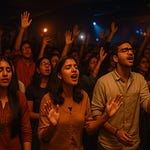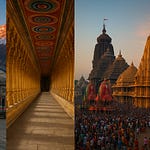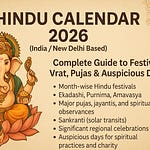🕉️ The Spiritual Capital of Maharashtra
Nestled on the banks of the holy Chandrabhaga River in the town of Pandharpur, Maharashtra, the Hari Vitthal Rukmini Mandir—also known as Shri Vitthal-Rukmini Mandir—stands as a radiant symbol of devotion, tradition, and the Bhakti movement. Revered by millions of devotees, this temple is not only the epicenter of Varkari Sampradaya but also a unifying spiritual hub across caste, class, and regional boundaries. It is lovingly referred to as “Bhu-Vaikuntha”, meaning the Vaikuntha (heaven) on Earth, as it is believed that Lord Vishnu himself resides here in the form of Vithoba with his consort Rukmini.
This comprehensive article explores the temple's origin, mythology, architectural marvels, rituals, festivals, spiritual essence, and the unmatched devotional fervor it inspires among pilgrims and saints alike.
📜 1. Origin & Founding
Mythological Foundation
The origin of the Vitthal Mandir is steeped in legend and Bhakti lore. The most popular tale centers around Pundalik, a deeply devoted son, whose service to his parents moved Lord Krishna (Vishnu). When Krishna visited Pundalik’s house, he was asked to wait as Pundalik was busy serving his parents. Pundalik offered a brick (vitth) for the Lord to stand on, upon which Krishna assumed a standing posture with hands on hips—a posture that defines Vithoba today.
Touched by Pundalik's devotion, Krishna decided to stay in Pandharpur permanently, blessing the region and becoming Vitthal, the Lord who waits.
Association with Saints
The temple is deeply associated with the Bhakti Movement saints:
Sant Dnyaneshwar, Sant Tukaram, Sant Namdev, Sant Eknath, and Sant Chokhamela are just a few of the many saints who have sung praises of Vitthal.
Their abhangs (devotional poems) and pilgrimages (dindi) to Pandharpur form the backbone of Maharashtra’s devotional culture.
🕰 2. Historical Timeline
12th–13th Century:
The temple flourished under the rule of the Yadava kings, who were known patrons of Vaishnavism and the Bhakti tradition.1237 CE:
Sant Dnyaneshwar, one of the greatest saints of Maharashtra, visited Pandharpur and composed several Abhangs (devotional verses) in praise of Lord Vitthal.14th–15th Century:
The temple faced threats from foreign invasions, which may have caused damage, but it was later repaired and revived by local devotees and leaders.17th Century:
A period of devotional resurgence during the Maratha Empire, especially under the patronage of Chhatrapati Shivaji Maharaj, who respected the Bhakti movement and its temples.19th Century:
The temple saw renovations and structural improvements carried out by local rulers and devotees to maintain its sanctity and infrastructure.Modern Day:
Currently, the temple is managed by the Pandharpur Temple Trust and has grown into a major pilgrimage destination, attracting millions of devotees annually from across India and beyond.
The temple has been consistently referenced in Marathi literature, Varkari oral traditions, and scriptures like Padma Purana and Skanda Purana.
🏛 3. Architecture & Design
Style
Built in Hemadpanthi style, an ancient form of Deccan stone architecture using lime, black basalt, and iron.
Minimal use of mortar, relying on interlocking stones for durability.
Key Architectural Highlights
Garbhagriha (Sanctum Sanctorum): Houses the 3.5-foot black basalt idol of Vitthal, standing on a brick with arms akimbo.
Rukmini Mandir: A separate yet connected shrine within the temple complex.
Shikhar (Spire): Tall and pyramid-shaped stone towers.
Sabha Mandap (Assembly Hall): Large congregational hall for chanting and bhajans.
Namdev Payari: Sacred steps named after Sant Namdev, believed to be where he attained darshan of Vitthal.
Artistic Treasures
Intricate carvings, murals, and pillars etched with motifs of deities, devotees, and animals.
Chhatris (cenotaphs) built in memory of saints.
🌌 4. Spiritual Significance
The Vitthal-Rukmini temple is the spiritual heart of Maharashtra and a beacon of egalitarian worship.
Considered one of the holiest sites for Vaishnavites, akin to Tirupati or Dwarka.
The deity Vitthal is a symbol of patience, devotion, compassion, and divine humility.
The temple is also the seat of Varkari Sampradaya, where devotion (bhakti) outweighs rituals.
The Chandrabhaga River (a U-bend of Bhima River) flowing beside is considered as sacred as Ganga.
🙏 5. Puja & Rituals
Daily Seva Timings:
Kakad Aarti (Morning Wake-Up Aarti) – Approximately 4:00 AM
This is the first aarti of the day, performed in the early pre-dawn hours to wake up Lord Vitthal. It includes devotional singing and lighting of lamps. The temple bell is rung, and the idol is gently awakened with sacred chants.Abhishek (Ritual Bathing of the Deity) – Approximately 5:30 AM
After Kakad Aarti, the deity undergoes Abhishekam, a sacred bathing ritual with water, milk, honey, curd, ghee, and holy items. This is followed by Shringar (decoration) with flowers, garments, and ornaments.Naivedyam (Offering of Food) – Approximately 11:00 AM
A variety of traditional food items are offered to the Lord as Naivedya. This ritual includes Bhog aarti, and devotees are later given prasadam.Dhup Aarti (Evening Worship) – Approximately 7:00 PM
The evening worship includes offering of incense (dhup), lamps, and devotional music. It is one of the most beautiful times to witness the divine atmosphere in the temple with singing and kirtans.Shej Aarti (Night Ritual) – Approximately 10:00 PM
This is the final ritual of the day, marking the Lord’s rest. The deity is offered milk, the temple is cleaned, and lullaby-like bhajans are sung to bid the deity good night.
Rituals are performed by Badwa priests, hereditary priests from ancient traditions.
Devotees often perform Pada Puja (worship of Vitthal’s feet), Tulsi Mala Puja, and Nama Jap (chanting).
🎊 6. Festivals Celebrated
Festivals Celebrated at Hari Vitthal Rukmini Mandir, Pandharpur
Ashadhi Ekadashi (June–July)
This is the most significant and grandest festival celebrated at the temple. It marks the culmination of the annual Warkari pilgrimage where lakhs of devotees (Warkaris) walk barefoot in Padayatras (foot pilgrimages) from towns like Alandi, Dehu, Pune, and other regions to Pandharpur. The entire town transforms into a vibrant sea of devotion with singing, dancing, chanting of “Vitthal Vitthal,” and spiritual unity. The darshan of Lord Vitthal on this day is considered supremely auspicious.Kartiki Ekadashi (October–November)
This festival is considered equally sacred as Ashadhi Ekadashi and draws huge crowds of devotees to the temple. The devotional fervor peaks, and the air resonates with kirtans, abhangs, and Hari Path sung throughout the day and night. Warkari groups from different regions arrive in large numbers, creating a divine and emotionally charged spiritual atmosphere.Maghi Ekadashi & Chaitra Ekadashi (January–February & March–April)
These two Ekadashis are celebrated with devotion, bhajans, kirtans, and fasting. Although the crowds are smaller compared to Ashadhi and Kartiki, the environment remains spiritually enriching and peaceful. Many devotees choose this time for a quieter darshan and deeper meditative experiences.Janmashtami (August–September)
Celebrated as the birth anniversary of Lord Krishna, Janmashtami at the Vitthal Mandir is observed with special pujas, midnight aarti, devotional singing, and kirtans narrating the life and leelas (divine plays) of Krishna. The temple is beautifully decorated, and devotees participate in fasting and singing through the night.Gudi Padwa, Holi, and Diwali (Pan-Indian Festivals)
These national festivals are celebrated with traditional devotion and regional customs.Gudi Padwa marks the Hindu New Year and is observed with pujas, hoisting of the Gudi, and seeking divine blessings.
Holi is celebrated with colors, community gatherings, and songs praising the Lord.
Diwali, the festival of lights, sees the temple illuminated, and special Laxmi-Vitthal pujas are performed. These festivals are also opportunities for social harmony and religious unity.
🎶 7. Bhajans & Cultural Aspects
Abhangs: Soulful Marathi devotional songs by saints like Sant Tukaram, Sant Dnyaneshwar, Sant Namdev.
Instruments: Taal, Mridanga, Veena, Harmonium.
Cultural events:
Dindi dances during yatra processions.
Ramleela, Hari Katha, and Kirtans held in temple halls.
Hari Path recitals energize the temple atmosphere.
🔔 8. Aarti Timings & Daily Schedule
Kakad Aarti: 4:00 AM
Abhishek & Shringar Puja: 5:30 AM–8:00 AM
Naivedya & Darshan: 11:00 AM onwards
Evening Dhup Aarti: ~7:00 PM
Shej Aarti: ~10:00 PM
Darshan Hours: 4:30 AM – 11:00 PM
Best time for peace: Post-lunch or early morning.
📿 9. Special Satsangs, Functions & Events
Sant Samagam: Annual spiritual gathering of Varkari saints.
Kirtan Mahotsavs: Massive devotional song events during Ekadashi and other festivals.
Padayatras (Dindis):
Organized from places like Alandi, Dehu, Kolhapur, culminating in Pandharpur.
Devotees walk barefoot, chanting and singing.
🔮 10. Special Pujas & Mystical Beliefs
Charan Seva (Washing of the deity’s feet) believed to bring good health and peace.
Naam Smaran (Chanting) is said to heal emotional and physical ailments.
Standing deity on brick signifies the Lord’s promise to wait for every devotee.
Beliefs include blessings of child birth, prosperity, peace, and moksha.
❤️ 11. Devotee Experience
Atmosphere: Deeply devotional, vibrant, and communal.
Peak days: Expect footfalls in lakhs, yet crowd management is peaceful.
Spiritual Testimonials: Many devotees recount miracles, emotional relief, and divine dreams.
Facilities:
Free meals (Annadanam)
Clean drinking water, cloakrooms, wheelchair access
Rest houses (Bhakta Niwas) with basic and deluxe rooms.
🛣 12. Travel & Visitor Information
How to Reach:
By Rail: Pandharpur Station is connected to Pune, Solapur, Mumbai.
By Road: MSRTC buses and cabs available from all major cities.
By Air:
Nearest Airport: Solapur (~75 km)
Alternative: Pune International Airport (~215 km)
Where to Stay:
Temple-managed Bhakta Niwas
Budget hotels, lodges, and dharmshalas
Premium hotels for family travelers
Guidelines:
Dress code: Modest clothing; sarees, salwars, dhotis preferred.
No photography inside sanctum.
Online booking available during festivals.
Guides available for temple and town tours.
💰 13. Other Details
Temple Trust: Under Government of Maharashtra via Shri Vitthal Rukmini Mandir Samiti.
Donations:
Accepted online and at temple counters.
Used for food distribution, maintenance, and community service.
Religious Shops: Tulsi malas, puja kits, books, prasadam.
Digital Presence:
Website: www.vitthalrukminimandir.org
Live darshan streams available during major events.
The Hari Vitthal Rukmini Mandir of Pandharpur is not just a temple—it is a living confluence of divinity, culture, devotion, and inclusivity. From chanting abhangs with fellow Warkaris to experiencing soul-touching aartis, every moment here is a spiritual rejuvenation. For centuries, it has offered solace, miracles, and a doorway to the divine for millions. Whether you're a pilgrim, a seeker, or a cultural explorer—Pandharpur calls with open arms and a patient Lord who never stops waiting.










